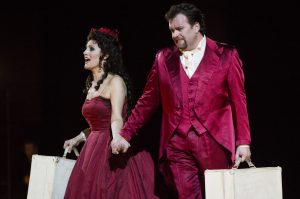Summer Music in the Air at Pitti & Medici Villas

With June comes summer, when classical music ensembles relocate to a nearby park or garden to the relief of audience members and musicians alike; in Verona, performances are set at the ancient Roman Arena, Rome in the suggestive Caracalla Baths. Florence doesn’t lack in beautiful palaces and gardens and since the Maggio Musicale Festival was founded in 1933, it has been a tradition to move to various locations at the Pitti Palace and Boboli Gardens.
This June and July, the Maggio Musicale Fiorentino will take up residence for two months at the Cortile dell’Ammanati, Pitti’s majestic courtyard. The summer season offers four opera titles and a number of symphonic concerts at 9:15 pm.
June
MMF
The Opera di Firenze, as the season’s finale, will host the Filarmonica “Gioacchino Rossini” to celebrate the 150th anniversary of Florence’s symphonic band on June 1. The ensemble was established in the Santa Croce neighborhood during the era that Florence was capital of Italy (1867). Acclaimed violinist Virginia Ceri will perform Parabola, concerto for violin and wind orchestra by Claudio J. Boncompagni under the guidance of Giampaolo Lazzari, the musical and artistic director since 2000. Scheduled at 9 pm, entrance is free of charge.
La Cenerentola (Cinderella, or Goodness Triumphant) by Gioacchino Rossini, loosely based on the iconic fairy tale by Perrault, will be held in Pitti Palace courtyard on June 9, 15, 21, 27 and 30. While there is a wicked stepfather instead of a stepmother and Prince Ramiro’s tutor, Alidoro, replaces the Fairy Godmother, the storyline still mirrors the heartwarming tale of the young heroine’s rise from rags to riches. Rossini was just 25 when he composed this sparkling score, first performed in Rome in 1817.
The first symphonic concert, conducted by 32-year-old Michele Gamba, will take place on June 14. The principal trombonist of the Maggio, Fabiano Fiorenzani, will be in the spotlight during the Concerto per trombone e orchestra by Nino Rota. An extraordinarily prolific composer, Rota is best known for his work as a composer of film scores, including ‘The Godfather’ trilogy, many Fellini films and Zefferelli’s ‘Romeo and Juliet.’ The performance concludes with Beethoven’s Symphony n. 8 (1812), which the composer affectionately called “my little Symphony in F.”
Perhaps the most performed and beloved opera of all is Verdi’s La Traviata, which will grace Pitti’s open-air stage from June 16 to July 1. The work is based on La Dame aux Camélias (1852), a play adapted from the novel by Alexandre Dumas, fils and tells the tragic tale of the courtesan Violetta, la ‘traviata’ or ‘fallen woman.’ Inspired by Fellini’s great film, La Dolce Vita, in this production the director has moved the scene from Paris in the early 1800s to 1950s Italy.
ORT
Luca Guglielmi will guide the Orchestra della Toscana in an interpretation of Mozart’s Symphony No. 1, which the composer wrote at age eight in London, Haydn’s Concerto No. 2 with cello soloist Augusto Gasbarri and Beethoven’s Second Symphony at Villa La Petraia (June 8) and Villa di Cerreto Guidi (June 10), both UNESCO World Heritage sites at 9:30 pm.
The two stately Medici country manors are featured once more as settings respectively on June 15 and 16, with the same program presented at Villa Poggio a Caiano on June 17. The musicians will give a rendition of compositions by Nino Rota in addition to Vivaldi’s “Four Seasons.”
An hour beforehand, the audience is invited to visit each estate, with the exception of Poggio a Caiano.
Villa La Petraia and its gardens were mainly designed under the rule of the Medici family, but several owners contributed to the architecture over the centuries, beginning in the 1300s. Among others, it was home to the mistress, and later wife of King Vittorio Emmanuele II, Rosina, whose belongings are now on display. A sculpture of Venus by Giambologna is found in the garden and Uten’s famous paintings in lunette form of the Medici villas are exhibited on the ground floor.
Situated among marble busts and family portraits, and original 15th, 16th and 19th century furniture and furnishings at Cerreto Guidi are exhibits that recall hunting, a favorite Medici family pastime in the countryside, evident even in a depiction of Anna Maria de’ Medici. The last Medici descendant, she willed the family’s collection at the Uffizi Gallery to the city of Florence for posterity.
July
Gaetano Donizetti’s L’elisir d’amore is a sweetly romantic, comedic romp has been one of the most popular operas since its triumphant 1832 opening in Milan. The action is set in motion when a traveling salesman arrives in town selling among other things, his ‘elixir of love.’ Highlighting the whimsical aspects of the piece, the setting has been moved to a small town in 1970s U.S.A.
Rossini’s opera buffa (literally ‘funny opera’) Il Barbiere di Siviglia (The Barber of Seville) was written by him in just 13 days, and is considered to be one of the greatest masterpieces of comedy set in music. After the 1816 premiere that was plagued with mishaps and paid dissenters, the piece was so successful that just a few years later in 1825 it was performed in New York City. Originally set in nineteenth century Seville, the fanciful production by the MMF has placed it in no specific time, allowing guests to focus on enjoying the brilliant comedy and music. (anne lokken)
